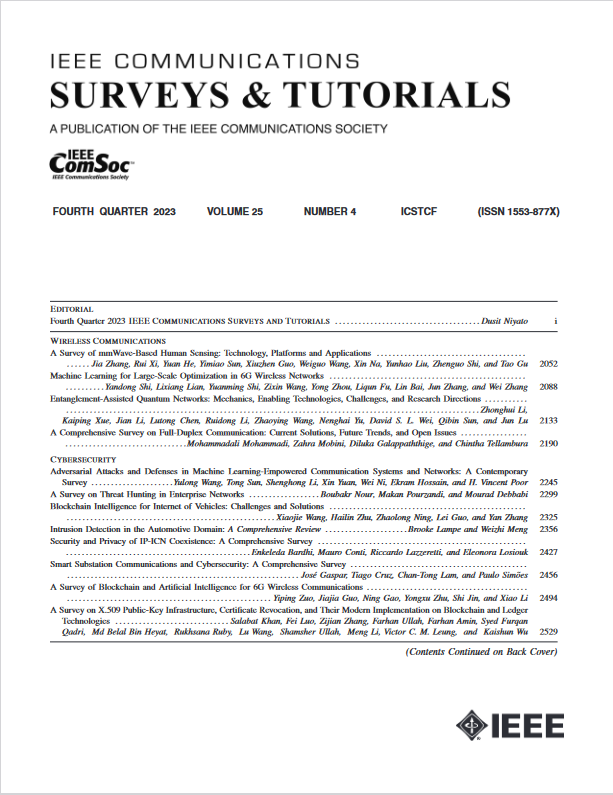面向 5G 及其他安全的 XAI 调查:技术方面、挑战和研究方向
IF 34.4
1区 计算机科学
Q1 COMPUTER SCIENCE, INFORMATION SYSTEMS
引用次数: 0
摘要
随着5G商业化的到来,预计下一代超越5G (B5G)无线接入技术将需要更可靠、更快、更智能的电信系统。人工智能(AI)和机器学习(ML)在服务层应用程序中非常受欢迎,并被认为是5G及以后网络的许多方面的重要推动因素,从物联网设备和边缘计算到基于云的基础设施。然而,现有的基于5G ML的安全调查倾向于强调AI/ML模型的性能和准确性,而不是模型的问责性和可信度。相比之下,本文探讨了可解释人工智能(XAI)方法的潜力,这将使5G及以后的利益相关者能够检查用于保护下一代网络的智能黑匣子系统。在5G及以后的安全领域使用XAI的目标是允许基于ml的安全系统的决策过程对5G及其他利益相关者透明和可理解,使系统对自动化行为负责。在即将到来的B5G时代的各个方面,包括B5G技术,如ORAN、零接触网络管理和端到端切片,本调查强调了XAI在其中的作用,这些作用最终将为普通用户所享受。此外,我们还介绍了最近的工作经验和未来的研究方向,以及目前正在进行的涉及XAI的项目。本文章由计算机程序翻译,如有差异,请以英文原文为准。
A Survey on XAI for 5G and Beyond Security: Technical Aspects, Challenges and Research Directions
With the advent of 5G commercialization, the need for more reliable, faster, and intelligent telecommunication systems is envisaged for the next generation beyond 5G (B5G) radio access technologies. Artificial Intelligence (AI) and Machine Learning (ML) are immensely popular in service layer applications and have been proposed as essential enablers in many aspects of 5G and beyond networks, from IoT devices and edge computing to cloud-based infrastructures. However, existing 5G ML-based security surveys tend to emphasize AI/ML model performance and accuracy more than the models’ accountability and trustworthiness. In contrast, this paper explores the potential of Explainable AI (XAI) methods, which would allow stakeholders in 5G and beyond to inspect intelligent black-box systems used to secure next-generation networks. The goal of using XAI in the security domain of 5G and beyond is to allow the decision-making processes of ML-based security systems to be transparent and comprehensible to 5G and beyond stakeholders, making the systems accountable for automated actions. In every facet of the forthcoming B5G era, including B5G technologies such as ORAN, zero-touch network management, and end-to-end slicing, this survey emphasizes the role of XAI in them that the general users would ultimately enjoy. Furthermore, we presented the lessons from recent efforts and future research directions on top of the currently conducted projects involving XAI.
求助全文
通过发布文献求助,成功后即可免费获取论文全文。
去求助
来源期刊

IEEE Communications Surveys and Tutorials
COMPUTER SCIENCE, INFORMATION SYSTEMS-TELECOMMUNICATIONS
CiteScore
80.20
自引率
2.50%
发文量
84
审稿时长
6 months
期刊介绍:
IEEE Communications Surveys & Tutorials is an online journal published by the IEEE Communications Society for tutorials and surveys covering all aspects of the communications field. Telecommunications technology is progressing at a rapid pace, and the IEEE Communications Society is committed to providing researchers and other professionals the information and tools to stay abreast. IEEE Communications Surveys and Tutorials focuses on integrating and adding understanding to the existing literature on communications, putting results in context. Whether searching for in-depth information about a familiar area or an introduction into a new area, IEEE Communications Surveys & Tutorials aims to be the premier source of peer-reviewed, comprehensive tutorials and surveys, and pointers to further sources. IEEE Communications Surveys & Tutorials publishes only articles exclusively written for IEEE Communications Surveys & Tutorials and go through a rigorous review process before their publication in the quarterly issues.
A tutorial article in the IEEE Communications Surveys & Tutorials should be designed to help the reader to become familiar with and learn something specific about a chosen topic. In contrast, the term survey, as applied here, is defined to mean a survey of the literature. A survey article in IEEE Communications Surveys & Tutorials should provide a comprehensive review of developments in a selected area, covering its development from its inception to its current state and beyond, and illustrating its development through liberal citations from the literature. Both tutorials and surveys should be tutorial in nature and should be written in a style comprehensible to readers outside the specialty of the article.
 求助内容:
求助内容: 应助结果提醒方式:
应助结果提醒方式:


